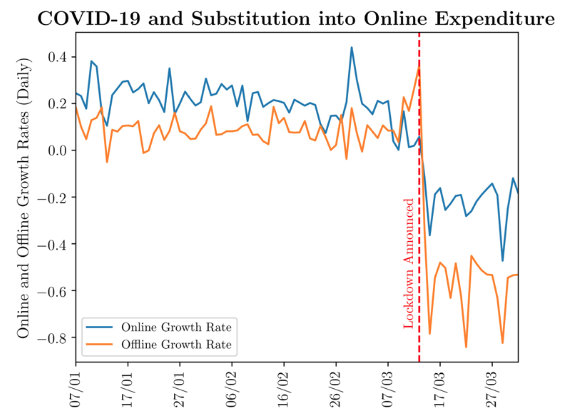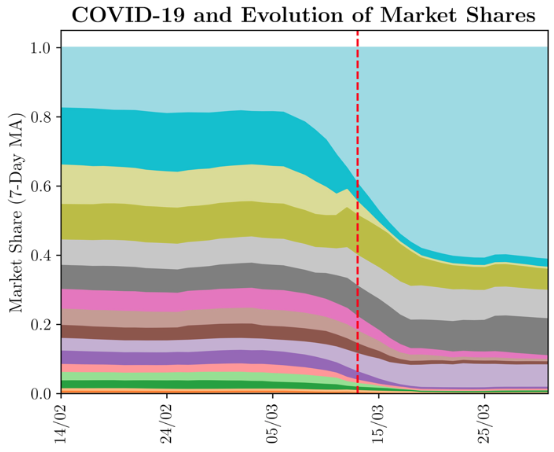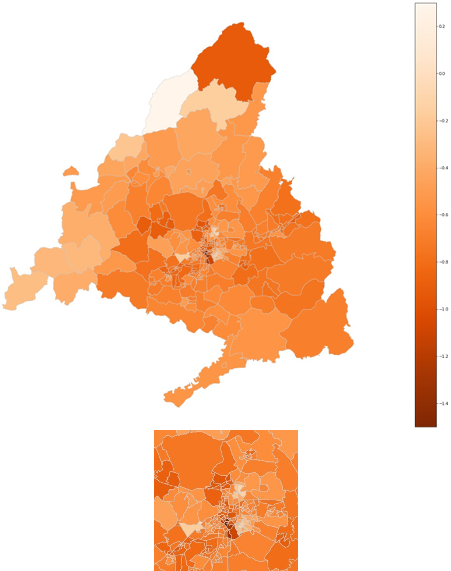Naturally occurring data held by commercial banks is rich, plentiful, granular, and directly connected to economic behaviour. This makes it uniquely suited to the real-time tracking of economic activity. This not only renders it a means for providing a backward-looking account of how COVID-19 has impacted the economy, but also provides a way to assess the effect of policies with minimal delay.
Since the outset of the crisis, there has been a surge of research on these issues. It is feared that the disruption induced by the pandemic (and the lockdown) will cause an extremely severe recession (Baldwin and Weder di Mauro 2020a, 2020b). There have also been first attempts at assessing the effect of mobility restrictions induced by the lockdown measures (Monras 2020). The most complementary papers are Baker et al. (2020), which uses a sample of financial transaction data from a personal finance application to study spending patterns in the US during March 2020, and Andersen et al. (2020), which uses credit card consumption data from a Danish bank to track the impact of the lockdown in Denmark.
In a recent paper (Carvalho et al. 2020), we use the universe of transactions mediated by Banco Bilbao Vizcaya Argentaria, S.A (BBVA) to build a daily expenditure measure, assessing the ability of transaction data to capture the recent economic dynamics in Spain. Spain has been hit particularly hard by the COVID-19 pandemic. The first confirmed case was seen on 31 January 2020, which was then followed by a gradual diffusion of the disease during February and March, reaching 200,210 confirmed cases and 20,852 confirmed deaths by 20 April 2020. On 31 March 2020, a strict lockdown policy was announced across the whole country and imposed immediately after. We aim to accurately evaluate the effect of these events on expenditure across sectors and geographic areas.
Our main dataset builds up from 1.4 billion individual card transactions. The ‘universe’ of BBVA transactions (be it from the cards issued via the bank, or the Points of Sales terminals it operates) provides a daily account of expenditures. As we document in Carvalho et al. (2020), the long-run time series of expenditures of BBVA accurately tracks private consumption in Spain. Given the metadata associated with each transaction, we are also able to disaggregate the high-frequency national level expenditures data into geographical, sectoral, and online/offline daily expenditures, providing more micro-detail on the unfolding of the crisis in Spain.
The COVID-19 crisis in real time
Throughout this research, we calculate the growth rate of expenditures for every day of the year 2020 with respect to the same day in 2019. We then look at the evolution of this year-on-year growth rate of expenditures across the sectors and geographic areas, interpreting it in light of the timeline of the pandemic.
Figure 1 shows the evolution of expenditures among Spanish Nationals. We find a large, abrupt, and persistent decline in expenditures in the period immediately following 14 March 2020 (the nationwide lockdown by the Spanish Government). For an average day in this period, aggregate (nominal) expenditures in Spain are roughly half as low (-49%) when compared to the same day one year before (in 2019). On the righthand side of the graph we present the implied aggregated non-durable consumption equivalent, obtained from calibrating the BBVA long-run time series to the official national accounts. This accounts for a year-on-year decline in non-durable consumption of approximately 13%.
Figure 1 Year-on-year growth of daily total expenditures by nationally issued cards
Notes: Blue line: Raw data. Orange line: seven day, centered moving average of raw data. Left Y-axis: BBVA daily expenditure growth; Right Y-axis: Implied aggregate non-durable consumption growth daily Y-o-Y growth by rescaling expenditure growth.
There is also evidence for stockpiling behaviour in the days immediately preceding the lockdown. During this brief period, at its maximum, year-on-year daily expenditure growth was 20 percentage points above of the mean growth observed in the first two months of 2020. Neither the massive spending fall nor the stockpiling behaviour happen uniformly across sectors, forms of trade, or even geographic units.
We also find considerable substitution from offline to online purchases after the lockdown. Figure 2a shows that both online and offline expenditures fell, but online ones substantially less, resulting in a large and stable increase in the market share of online expenditure, which grew by about 50% (figure 2b).
Figure 2 Effect of crisis on online vs offline sales
a) Daily Year on Year growth rate of online (blue) and offline expenditures (orange) by nationally-issued cards
b) Seven day moving average of daily market share of online transactions by nationally issued cards
As should be expected, not all sectors have been affected in the same manner. There is substantial heterogeneity across categories of expenditure during the lockdown period. Consistent with the nature of the lockdown (which allows only essential market interactions), we find that expenditure in commodities related to basic necessities (such as foodstuffs and healthcare/pharmacy products), or that cater to goods with very low demand elasticity (such as tobacco), more than doubled during the lockdown period, relative to the same period in the previous year. In contrast, expenditure on goods and services with higher demand elasticities (related to food and entertainment away from one’s residence, fashion, or personal services) has all but vanished. This gives rise to a large reallocation in expenditure across categories of goods and services.
This can be noticed in figure 3, where we disaggregate the economy into 18 broad categories and plot the time series of the market share of each. Expanding from this analysis, we next divide the economy into 76 narrower definitions and evaluate the ten subsectors whose market share increased the most, and the ten whose market share decreased the most.
Figure 3 The evolution of market shares for broad expenditure categories
Notes: Categories are stacked top to bottom in order of pre-crisis shares. The red dash indicates the announcement of the lockdown. Shares are expressed as a seven-day moving average.
In figures 4a and 4b we plot the evolution of the year-on-year growth rates of expenditures and market share (respectively) of these two groups of subsectors.
Figure 4 Evolution of the year-on-year Growth rates and market share of the best and worst performing categories of expenditure.
a) Year-on-year growth rate of the 10 best and worse performing categories
b) Aggregate market share of the 10 best and worse performing categories
Taken collectively, the top ten best performing categories of expenditure following lockdown have increased their market share from an average of 20% to more than 50%. Moreover, the sales of the best performing sectors (all essential and/or goods with low demand elasticity) witnessed a very substantial increase in the first week of the lockdown (and in anticipation of it), and have stabilised since at approximately the same level that one would expect in the absence of pandemic. The stark difference is the absolute collapse of sectors that either are incompatible with the social-distancing rules of the lockdown measures (like bars and restaurants, or massages), or are classified as non-essential goods (like fashion and luxury goods).
On the geographical distribution of the effects of the pandemic we perform two sets of exercises. We first evaluate the cross-sectional dispersion at the level of Spanish Regions, Spain’s Comunidades Autónomas. These display differential onset and growth of the pandemic. Yet, variations in expenditure across time and regions seems only to reflect the nationwide lockdown and its restrictions to mobility and market interactions. In particular, we do not find evidence that the differential exposure to the pandemic (across regions) affected regional expenditure dynamics. Moreover, we find no strong statistical evidence that poorer regions adjusted their expenditure differently from richer regions.
We next examine expenditure patterns at a much more micro level, using zip code level expenditure from the Madrid region. Here we find evidence of heterogeneous effects across space. In figure 5 we plot the dispersion in expenditure across Madrid zip codes. The trend begins rising significantly a week before the lockdown, and remains significantly higher post-lockdown, when compared to January and February 2020.
Figure 5 Dispersion (IQR) of year-on-year daily growth of expenditures across ZIP codes in Madrid
In figure 6 we present a ‘heat map’ of the change on expenditures before and after the lockdown across the geography of the region of Madrid.
Moreover, we conduct a preliminary analysis of what drives this zip code level heterogeneity and find that zip codes with a higher incidence of COVID-19 cases suffer more from the lockdown, as measured by expenditure falls.
Figure 6 Heat map of difference in average year-on-year growth rate of expenditures before March 9th, and after March 13th
Note: Darker colour indicates a larger fall after the implementation of the lockdown.
Conclusions
The paper provides a unique and novel set of facts about how spending patterns evolved during the build-up of the crisis and in the aftermath of lockdown measures. This helps quantify the impact of these events, as well as how their costs are distributed throughout the Spanish economy.
In addition to this, we show that these facts can be established with data derived from a vast well of naturally occurring information. Because such data is available in nearly every country, exercises such as ours can be replicated and extended in many different environments. These should be of immediate value for dealing with the current situation,1 and may also be informative in the longer-term future as well.
These results will hopefully stimulate efforts to exploit financial transaction data more broadly in economics and finance, which will necessarily require collaborations between private-sector, public-sector, and academic entities.
References
Andersen, A L, E T Hansen, N Johannesen and A Sheridan (2020), “Consumer responses to the covid-19 crisis: Evidence from bank account transaction data”, Covid Economics 7: 88-114.
Baker, S R, R Farrokhnia, S Meyer, M Pagel and C Yannelis (2020), “How does household spending respond to an epidemic? Consumption during the 2020 covid-19 pandemic”, Working Paper.
Baldwin, R and B Weder di Mauro (2020a), Economics in the Time of COVID-19. London: CEPR Press, VoxEU.org eBook.
Baldwin, R and B Weder di Mauro (2020b), Mitigating the COVID Economic Crisis: Act Fast and Do Whatever It Takes. London: CEPR Press, VoxEU.org eBook.
Carvalho, V, S Hansen, A Ortiz, J R García, T Rodrigo, J V Rodríguez Mora and P Ruiz (2020), “Tracking the covid-19 crisis with high-resolution transaction data”, CEPR DP, 14642.
Monras, J (2020), “Some thoughts on covid-19 from a labour mobility perspective: From ‘red-zoning’ to ‘green-zoning’”, VoxEU.org, 25 March.
Endnotes
1 Ongoing work providing further details on the reactions of households and firms as well as a near real time tracking of the relaxation of strict lockdown policies in Spain will be reported in updates to (Carvalho et al., 2020).


















